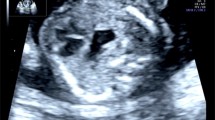Abstract
A routine ultrasound scan in a primigravida at 29 weeks' gestation showed that her fetus had a fluid-filled viscus above the diaphragm in the mid-line. This was initially thought to be the stomach, either as part of a congenital Bochdalek diaphragmatic hernia or an hiatus hernia. Subsequent scans suggested that this was the stomach with an additional loop of bowel. After birth, laparotomy confirmed that the stomach had herniated into the chest through a very lax oesophageal hiatus. The stomach was easily reduced into the abdomen with no evidence to suggest a congenital short oesophagus, the crura were tightened, and an anterior fundoplication performed.
Similar content being viewed by others
Author information
Authors and Affiliations
Additional information
Accepted: 26 February 1997
Rights and permissions
About this article
Cite this article
Chacko, J., Ford, W. & Furness, M. Antenatal detection of hiatus hernia. Pediatr Surg Int 13, 163–164 (1998). https://doi.org/10.1007/s003830050276
Issue Date:
DOI: https://doi.org/10.1007/s003830050276




